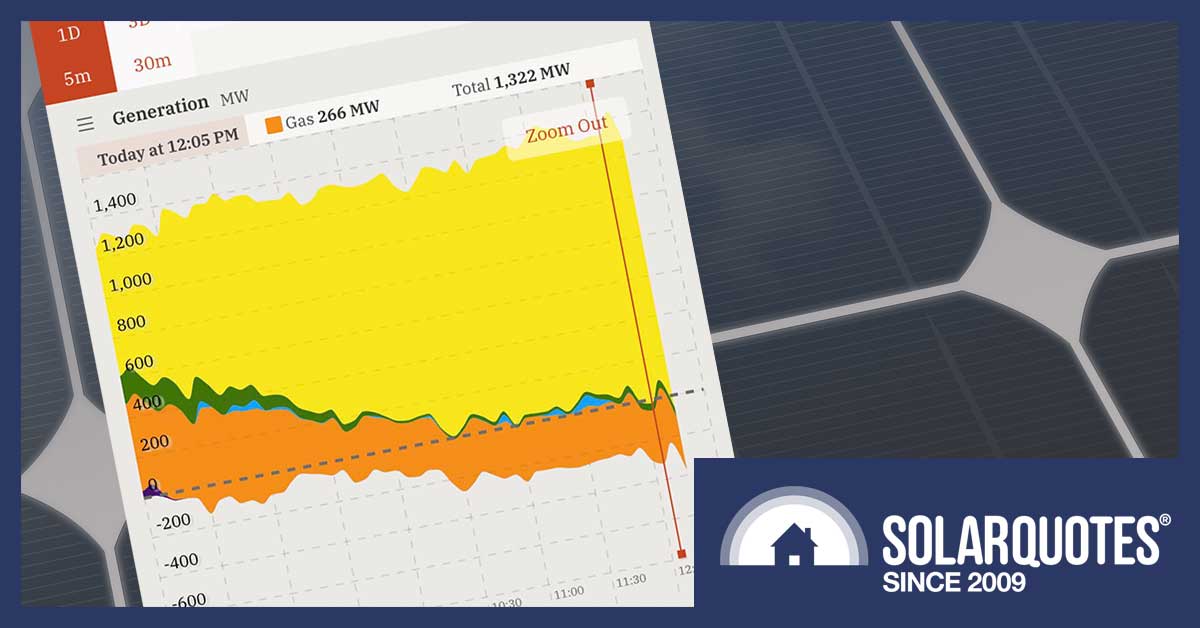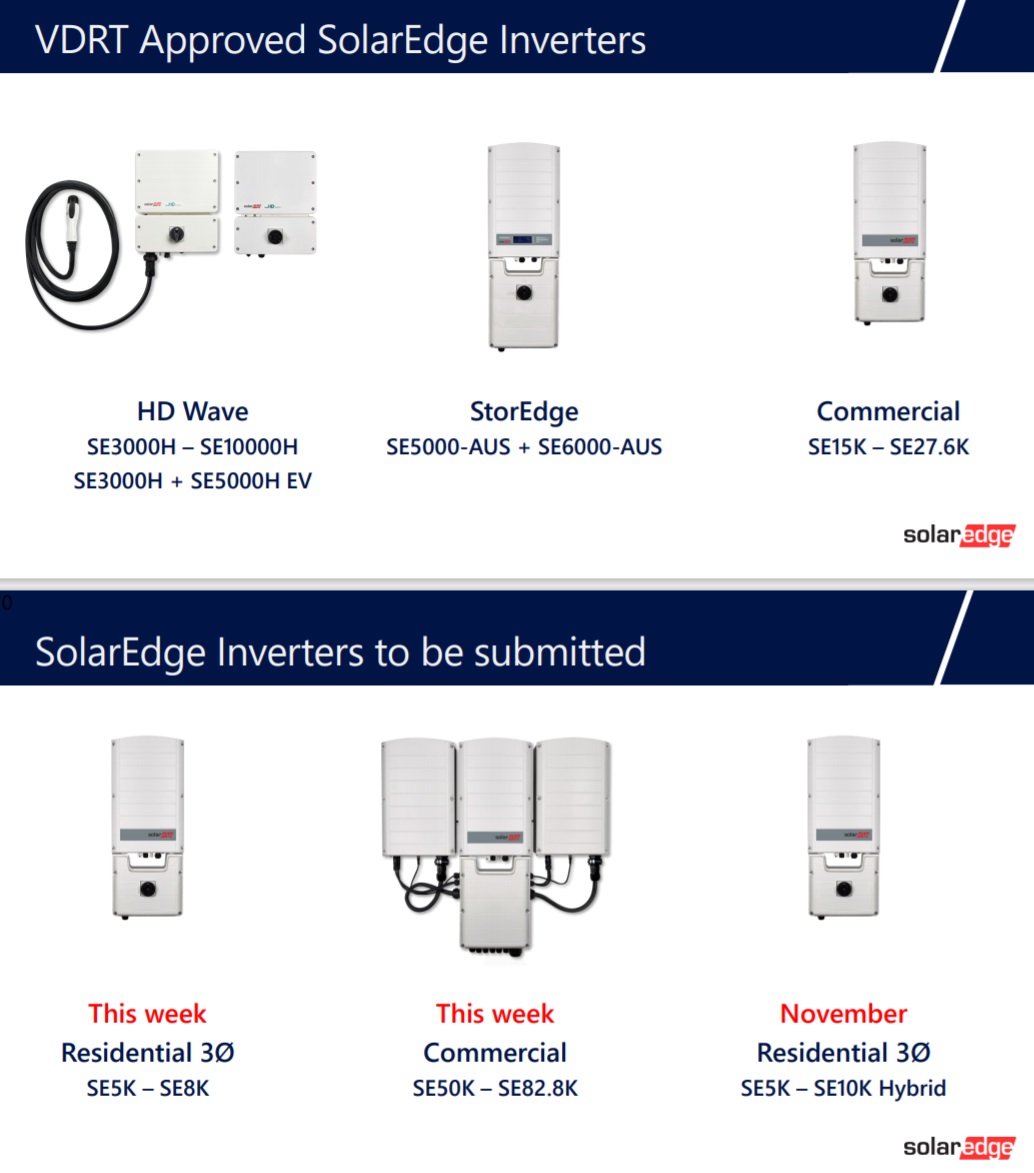
Yesterday in SA, solar met 100% of demand for a short period. Hence the need for remote curtailment of new solar. SolarEdge inverters can meet this requirement. Image: Rob Morris
Update 14th December 2020: Good news! SolarEdge has informed me they no longer charge an additional $165 to cover the cost of meeting South Australia’s new inverter requirements. SolarEdge instead now absorbs the cost, which is obviously good news for anyone thinking of getting a SolarEdge system in SA.
On Thursday at 3:58 pm I was invited to a SolarEdge webinar that started at 4:00 pm. I was glad to get the invite, but the lack of notice meant I missed out on the first 5 minutes because I didn’t have time to set up my laptop/internet properly beforehand. This was very appropriate because the webinar was about how SolarEdge had responded to new South Australian solar inverter requirements that were rushed in before the industry had time to properly prepare.
I learned many interesting things, but what stood out was how much the Remote Disconnection/Reconnection requirement adds to the cost of solar power. The amount will vary depending on the inverter manufacturer but for SolarEdge it’s an extra $165. As installers will need to do some extra paperwork the actual increase may be a bit more than that.
The good news is when SolarEdge inverters receive a Remote Disconnect signal they will only kill exports to the grid and continue supplying the home with solar energy. This includes charging a battery if there is one. While I expect solar inverters will only be Remote Disconnected for a few hours a year, if an inverter only stops exports that is clearly better than shutting down entirely. If you are concerned about disconnection periods lasting for a lot more than a few hours annually, then an inverter that lets your home still use solar is a sensible choice.
SolarEdge Says They Meet Requirements
There are two new requirements inverters must meet in order to now be installed in SA:
- Low Voltage Ride Through — This is the ability to keep functioning when the grid has a short duration low voltage disturbance. This is important because if enough rooftop solar power shuts down at once it could cause widespread blackouts.
- Remote Disconnection/Reconnection — The ability for the inverter or just solar inverter exports to the grid to be shut down remotely through the internet.
SolarEdge says their own testing shows their solar inverters now meet SA’s new requirements. Their single phase inverters are on the SA official list of those that are approved and their residential and commercial three phase inverters will appear on it soon.
In addition, SolarEdge says their inverters are ready for:
- Dynamic Export Control — Allows inverters to reduce their exports to a level the grid can handle when it is under pressure.
While the first two requirements have to work now, this one is still to be trialed by SAPN and isn’t ready to be implemented yet.
A Quick Shill…
SolarEdge has new residential 3 phase inverters I’ve been told will be available from the 1st of December. These will meet the new SA requirements and range from 5-10 kilowatts.
SolarEdge Requirements For Remote Disconnection/Reconnection
For SolarEdge inverters to meet the new requirements they must have a SolarEdge Energy Meter and CT clamps. These are now necessary for a grid-connected SolarEdge system to be installed in South Australia.
CT clamps are little sensors placed on electrical cables that let the system know when the home is importing or exporting energy. Last time I checked the SolarEdge Energy Meter was around $400 including retail markup and GST. Note the SolarEdge Energy Meter has a warranty of only 5 years and not the 12 years the inverter has. Obviously it would be convenient for customers and helpful for sales if it matched the dozen year solar inverter warranty.
Benefits of the energy meter and CT clamps are they enable the SolarEdge system be “smart” and let it provide detailed solar panel-level monitoring, which is better than what standard inverters can provide without a third-party monitoring system such as Solar Analytics. It also should prepare your home to become “smart”, with the ability to turn appliances on and off based on how much solar power is being produced. SolarEdge makes a sub $200 wireless AC Relay that can switch appliances on and off. This is a feature that will be particularly useful in Western Australia with their extremely low feed-in tariff for new solar.
Authorized Agent — SAPN Does It For Free
For Remote Disconnection/Reconnection to work, the manufacturer needs to provide the capability, but an Authorized Agent has to be appointed to be in charge of sending the control signals to the inverters. South Australia Power Networks (SAPN), which is responsible for the local distribution of power to homes and businesses, is offering to do this for free.
Because SAPN has skill, experience, and a strong incentive to keep the grid operating, I don’t see why any manufacturer wouldn’t use them given they charge nothing — provided of course SAPN is willing to have them.
Personally, I’m glad SAPN is providing the service for free because it screws over the plans of companies that were hoping to have another state government approved method of getting money out of households.
One Fee Fits All
The $165 fee for Remote Disconnection/Reconnection capability is with GST and the same for all SolarEdge solar inverters no matter their size, whether they are a tiny 2.5 kilowatts or a massive 83 kilowatt commercial inverter. This is fair in the sense that the cost of providing the ability will be the same for each inverter, but it does mean the fee will make up a larger chunk of the cost of a small solar power system. If the inverter on an old solar system that is only 1.5 kilowatts fails, it will now make even more financial sense to replace it with a larger system to reduce the cost per kilowatt of capacity.
Because old, small solar systems contribute very little to the problem of grid instability due to their low output and a higher percentage of solar electricity output is self-consumed by homes, I suspect it would make more sense to spend the money improving grid stability elsewhere. Unfortunately, this is exactly the sort of thing that gets overlooked when rule changes are rammed through in a rush.
Maybe, after careful consideration, they will decide to give existing small systems that need a new solar inverter a break.
One bit of good news about the fee is, if a site has multiple SolarEdge inverters, then one will be the master that tells the others what to do and the fee only applies to that one.
It Should Be A One-Off Fee
At first, SolarEdge told us the fee for Remote Disconnection/Reconnection would apply for the 12-year warranty of their inverters. When I asked what would happen after 12 years I was told that presumably, the fee would cover the solar inverter for its entire lifespan, both in and out of warranty, but they didn’t promise this.
If I was an installer, I would sure as hell want SolarEdge to promise in writing that the fee covers the inverter for as long as it remains operational. Otherwise, every time I tried to sell one I’d have to explain that once the warranty runs out the inverter may no longer meet South Australian requirements and may have to be disconnected from the grid. Because Australian Consumer Guarantees apply regardless of what’s written in the warranty or how long it lasts, as an installer I would be on the hook for a repair, replacement, or refund. This means I’d want to make it crystal clear they were buying something that could only be expected to last 12 years.
In reality, I wouldn’t try to sell them at all. If a manufacturer doesn’t state the inverter will remain functional for their entire lifespan I wouldn’t touch them with a 10-foot pole.

Margo Dydek, the sadly missed coach of the Northside Wizards, was a 7 foot 2 Pole. (Image: San Antonio Express-News)
I would expect any solar inverter manufacturer to promise that Remote Disconnection/Reconnection would remain supported for their product’s entire lifespan and not just the warranty period, which is often still only 5 years rather than the 12 years SolarEdge offers.
Overseas Actors Can Crash Our Grid
If we still had a state-owned and operated electricity sector, the state would tell manufacturers that all new inverters must have Remote Disconnection/Reconnection capability and the state would control it for the lifespan of every new solar inverter, as that would be the only sensible way to do it. But not only have we sold away state control over our grid for a mess of pottage, but we haven’t even kept complete control of the grid within our own country.

I’m not saying I wouldn’t eat the pottage, I’m just saying it’s not worth control over an entire grid. (Image: Times of India)
We’ve already handed over control of parts of our grid to companies in the United States and China1 by letting them have control over Virtual Power Plants. But the new SA inverter requirements dramatically increase the ability of overseas agents to dick around with our electricity grid.
Maybe this won’t be a problem because if all countries have fingers in each other’s software pies, no one will try anything stupid because the retaliation would be terrible. But just because it has worked with nuclear weapons so far doesn’t mean it’s a good idea.
Remote Disconnection Should Be Rare
Judging from some comments I’ve received, many people are worried Remote Disconnection will cause them to lose months of solar energy production per year, or — according to more over-the-top commenters — maybe two or three years per year and their solar power systems will somehow become energy vampires.
I recommend relaxing because I expect it will result in the average new solar system only losing a few hours of output a year. For systems like SolarEdge, this will only be exports, but many solar inverters will shut down entirely. Even with no production at all, for the average household with a 6.6 kilowatt system, this should cost them less than $20 in lost output per year.
SolarEdge said they were informed by SAPN to expect around 20 events per year where Remote Disconnection will be used. While this sounds bad, my understanding is they will generally be limited in both area and duration, so I think my prediction of just a few hours is likely to be right. (I’m actually hoping it will be even less, but this might just be because I have a bad case of optimism that not even being born in Toowoomba could cure.)
What It Means For Consumers
Exactly what the new SA inverter requirements mean for those buying new solar power systems isn’t entirely clear yet because the changes were so rushed. The need to take additional precautions to handle the increasing amount of distributed solar on the grid was easily predictable and if planning had started a year ago we’d be in a much better position to guess how things are likely to pan out. For example, we don’t even know how or if households will be informed of Remote Disconnection events so they’ll know their solar inverters aren’t malfunctioning and won’t ring up their installers to demand they come and fix them.
The cost of meeting the inverter requirements is being passed on to consumers, but the cost of a typical solar system over the past year has fallen by more than any amount solar inverter manufacturers are likely to add to their products to cover their cost, so the situation isn’t dire from the point of view of people’s wallets. Also, this is the sort of thing I expect to fall in price as technology improves and becomes standardized, so the additional cost should fall in the future.
Like SolarEdge, other manufacturers are likely to also add a flat increase to the cost of their inverters, regardless of capacity. As this will make smaller systems even more expensive on a per watt basis, it further increases the incentive to get a larger solar power system. This means my usual advice that most people should fill their roof with as many solar panels as they reasonably can is even more relevant.
A solar inverter that only stops exports when Remote Disconnection is activated is better than one that shuts down entirely – but because I expect this will only average a few hours of lost energy output a year, I don’t think people should be very concerned about having one that shuts down all production. Of course, all else equal, one that only cuts off exports is better.
Finally, if cyber-terrorists use inverters to crash our grid and take over South Australia, then I for one welcome our new cyber overlords. As a trusted blogger, I can be helpful in rounding up consumers to work in their underground bitcoin mines.
Footnotes
- At the moment I trust one of these countries to act sensibly. ↩


 RSS - Posts
RSS - Posts



The DC optimisers provide the panel monitoring.
The ‘solaredge smart meter’ provides monitoring of the power passing through the utility meter ….
This allows consumption to be calculated as:
Solar Generation Power minus Incoming Power.
100% thrilled that SolarEdge are only shutting down exports, rather than entirely.
“For SolarEdge inverters to meet the new requirements they must have a SolarEdge Energy Meter and CT clamps. These are now necessary for a grid-connected SolarEdge system to be installed in South Australia.
CT clamps are little sensors placed on electrical cables that let the system know when the home is importing or exporting energy. ”
I am wondering how this functionality of these SolarEdge inverters, compares with the equivalent functionality of the Goodwe GW-5048-ES inverters, which, I am advised, can be installed and operated, regardless of whether a battery storage system is also installed.
I wonder when Solar-Edge will stop end users having full configuration control over the inverter without an installer password. Pretty big loophole they have right now.
Gee whiz!! Shock-horror! –> “Overseas Actors Can Crash Our Grid”….. but can you explain how this is any different from our ‘local’ actors being able to crash our grid as-and-when (or when some computer glitches) without reference to the plugged-in bunnies?
eg. How is selling out our ‘local’ actors to foreign ones any different from Fred Nurk selling out HIS interests/control to said ‘local actors’/ ‘authorities’?
As always:- Stand-alone solar is the safest, most efficient and (by far) the cheapest way to go….. and becoming more so every day.
Never forget that “an offer he can’t refuse ” ALWAYS costs the recipient a motza ( up-font and escalating endlessly) for which he gets NOTHING. Little wonder there are so many football supporters in the joint.